This post is all about the layering system and the permutation window, what they are and how to use them…
A. The Layering System
B. The Permutation Window
A. THE LAYERING SYSTEM
Please watch the video (at right) for the best explanations and demonstrations of how to use this system.
What This System Does:
The purpose of this system is to allow you to quickly create and learn ANY COMBINATION OF RHYTHMS!
It is a tool made for drummers, to help you learn any pattern you want. It is specifically designed to maximize the learning process, by utilizing an ‘ostinato’ approach… each groove may easily be combined with hundreds of different rhythms.
The patterns are very easy to learn, because the combinations are displayed in ‘standard notation’ as well as ‘coordination notation’, which is a direct instruction for what movements to make for each note. Read more about ‘coordination notation’
This system was designed to be as convenient as possible, so the rhythmic combinations can be changed easily using the magnetic ‘layering window’.
It is versatile, featuring many grooves and rhythms in 12/8 time (triplet feel, four beats per measure) and 4/4 time (16th note feel, four beats per measure).
The layering system consists of 3 main parts:
1 – Magnetic ‘Layering Window’
2 – Transparent Cards
3 – Rhythms
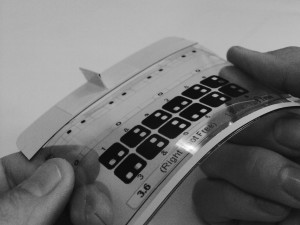
Magnetic Layering Window
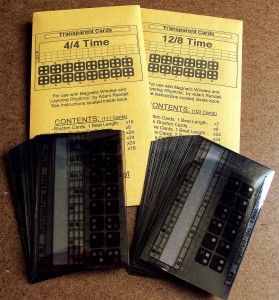
Transparent Cards
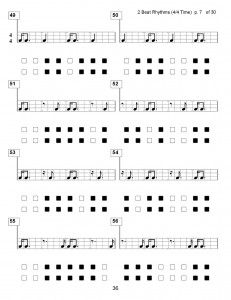
4/4 Time Rhythms In Book
1. Magnetic ‘Layering Window’
This device is actually very simple but amazing.
It is basically two windows of clear plastic, each affixed with flexible and powerful magnets that attract each other through a page, to provide horizontal and vertical grip which allows you to move the window easily around a page. There are cut-out tabs in the clear surface, to hold a transparent card securely in place without obstructing its graphics. A fold-down handle allows for easy re-positioning. It is flexible, durable and sturdy.
Directions for its use and demonstrations are best found in the ‘Part 1’ video at right, and in the book “Layering Rhythms.”
2. Transparent Cards
There are 214 cards sold in the ‘Transparent Cards Pack’, for use with the book “Layering Rhythms.”
CONTENTS: TRANSPARENT CARDS PACK (214 CARDS)
-7 (all 1-beat rhythm cards in 12/8 time)
-15 (all 1-beat rhythm cards in 4/4 time)
-16 (blank rhythm cards, 12/8 and 4/4 time)
-24 (1-beat groove cards in 12/8 time)
-24 (2-beat groove cards in 12/8 time)
-24 (4-beat groove cards in 12/8 time)
-24 (1-beat groove cards in 4/4 time)
-24 (2-beat groove cards in 4/4 time)
-24 (4-beat groove cards in 4/4 time)
-32 (blank groove cards, 12/8 and 4/4 time)
All of these cards are displayed in the book, in the ‘transparent cards’ section.
This system would still be complete and infinite with just the blank cards provided, but obviously that wouldn’t be as fun for people using the book. Instead, there is a large selection of material provided as a jumpstart for developing infinite coordination and vocabulary.
The grooves were painstakingly chosen, for maximum variety and benefit. The criteria for grooves I used in the book were: I wanted to provide some basic and useful rock grooves, some grooves in the styles of latin, funk and blues, some polyrhythmic, some linear, some heavily layered, and overall… grooves that would be extremely fun to play rhythms over the top of, that would also be practical for use in professional settings.
Each groove has several cards, to provide all possibilities for limb arrangements- to maximize the coordination abilities you can gain from each groove, and therefore the versatility of each groove.
The cards are printed on transparency film and are quite durable, and can easily be switched in and out of the magnetic ‘layering window’.
How To Make Extra Cards
If you lose any cards and need to replace them, or just want to print a few extra blank cards to customize, you can create more using the following guidelines.
Complete detailed instructions for this are printed in the book, “Layering Rhythms”… here are some useful guidelines.
Bring the book to a copy/print center of your choice, and ask for a transparency version of any of the ‘transparent cards’ pages. THERE IS PERMISSION GRANTED TO COPY THESE PAGES WRITTEN ON THE COPYRIGHT PAGE AT THE BEGINNING OF THE BOOK. Usually the price is between 50 cents and a buck per page. Despite the risk of offending their competitors, I have to be honest and say that Office Depot has given me the best results so far. I have run into various problems and/or steep prices while shopping around for this service, so I feel that this guidance is worth mentioning. Above all be sure to use laser printing, not ink, and be sure the employee DOES NOT select the option on their computer screen to ‘fit to page’ or ‘resize’ It doesn’t matter whether or not they choose the option to ‘auto-rotate and center.’
Once you have your transparent pages, cut them apart carefully along the solid black lines.
3. The Rhythm Catalogs
The rhythm catalogs in the books are highly developed- they include a 1-beat length section and 2-beat length section, in each of the two time signatures. Each section includes EVERY POSSIBLE RHYTHM IN THAT CATEGORY*, to ensure that a) you have all the choices you could want, and b) if you want to 100% fully develop your coordination by making all possible combinations with a certain groove, you can do so.
*THE MATH INVOLVED: There are 64 total rhythms in 12/8 time, including 8 in the 1-beat length section and 56 in the 2-beat length section. The 4/4 time section has 256 total rhythms, including 16 in the 1-beat length section and 240 in the 2-beat length section.
These numbers come from the calculation, TOTAL RHYTHMS = 2(# of counts in the pattern). In other words, for the 2-beat length section in 12/8 time, there are six counts total in those 2 beats.. so the calculation would be 26 = 2 x 2 x 2 x 2 x 2 x 2 = 64 total rhythms. 8 of those are 1-beat length rhythms, because there are 3 counts in 1 beat, so the calculation would be 23 = 2 x 2 x 2 = 8 total 1-beat rhythms.
These rhythm sections are also highly organized, for ease of use. The patterns are arranged from fewest notes per measure, in the beginning of each section, to most notes per measure, at the end of each section. This allows you to easily find groups of similar-feeling rhythms, which tends to increase your productivity.
B. THE PERMUTATION WINDOW
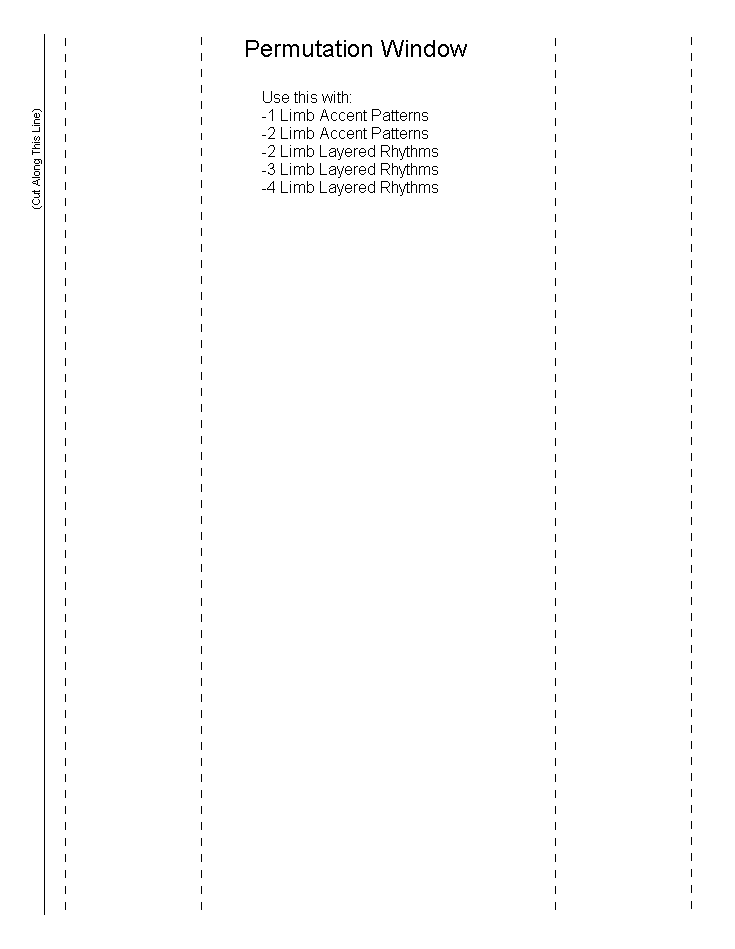
This device is used to MULTIPLY the patterns in the book, “Complete Coordination Training.” In order to fit a COMPREHENSIVE collection of exercises into one physical binding, it was necessary to utilize ‘permutations’..
A PERMUTATION is a shift in the starting point of a pattern, much like ‘inversions’ of chords on a keyboard. When patterns repeat themselves several times, permutations will not change the movements of the pattern itself, but will redefine its beginning point. For each permutation, the pattern will sound exactly the same but feel very different.
How To Use The Permutation Window:
This transparent page has two sets of dashed lines that are a certain distance apart, at the right and left edges of the page. You can use whichever edge of the page is more convenient for the page you are open to in the book. The dashed lines are the same distance apart as the length of one pattern in the book, for the sections it is compatible with.
It is designed to be used with these sections in “Complete Coordination Training”:
– 1 Limb Accents
– 2 Limb Accents
– 2 Limb Layered Strings
– 3 Limb Layered Rhythms
– 4 Limb Layered Rhythms
For these sections, the patterns are each written twice in a measure to facilitate the use of the permutation window.
The first exercise begins on the FIRST COUNT, and the permutation window would be placed so the dashed lines frame the first half of the measure. Repeat the contents within the dashed lines as many times as desired.
Then move the window so it frames everything from the SECOND COUNT through the FIRST COUNT OF THE SECOND HALF, and repeat the contents as many times as desired. Continue moving the window one count at a time and repeating the contents within the dashed lines… the next pattern would start on the THIRD COUNT and go through the SECOND COUNT OF THE SECOND HALF, and so on.
Continue this until you have played all permutations in the measure.
If the pattern has 5 counts, there will be 5 exercises- one starting on each count of the pattern.
Here is an illustration from a page in the book, in the 4 Limb Layered Rhythms section:
Make Sure To Use It!
The permutated patterns are ALL WORTH PRACTICING because they feel so different. They’re really unique, and are only condensed to the same written exercise so I wouldn’t have to write a book thousands of pages long. When you use this book, DON’T SKIP permutating the patterns because you cheat yourself out of so much material!
FREEDOM FROM DEPENDENCE (physical / mental)
There is also a phenomenon that happens with permutations. Your body’s muscle memory knows the sequence of movements, after learning the original pattern. Permutating it doesn’t change the sequence of these movements, just your perception of the pattern.
However, many permutated patterns may still feel physically challenging, not just mentally challenging. This is because your physical (muscle) memory is still ‘dependent’ on your mental memory. Once you become fully comfortable with all the permutations of an exercise, you begin to break this dependence.
Your playing overall will mature greatly from this exercise, because you’ve rehearsed the SAME physical sequence with lots of different ways of feeling it… you will have a deeper understanding and familiarity with counting, and more versatility with your playing. Furthermore, while practicing permutations you gain more rehearsal on the physical sequence, so it advances quickly toward muscle memory status.
An exercise to solidify this progress: Try running through each permutation of the exercise several times. Then, try switching permutations while playing: without stopping the pattern, mentally redefine the ‘one’ of the pattern and switch your perception to feel it start there.
Replacement
Here’s a copy of the page for download, if you need a replacement. (Bring the file or a printed copy of it to a copy/print center of your choice, and ask for a transparency version of it. Usually the price is between 50 cents and a buck.) Office Depot has given me the best results so far.. it is important to use laser printing, not ink.. and make sure the employee doesn’t have the box checked next to ‘fit to page’. ‘Auto-rotate and center’ is ok checked or unchecked.
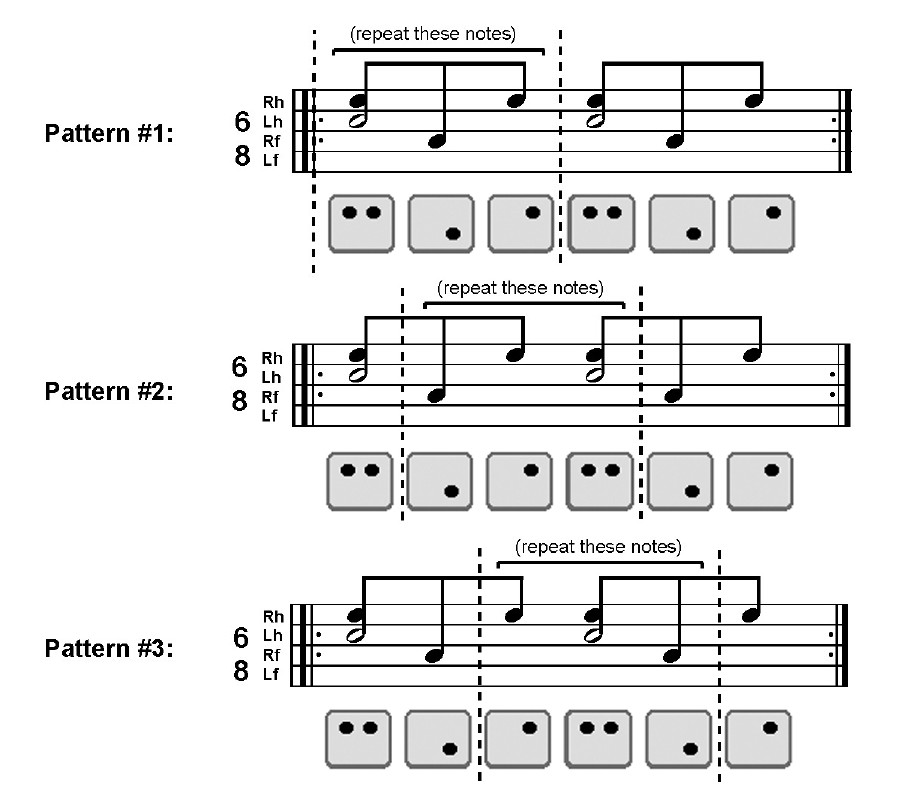
Thank you a lot for sharing this. Awsome!